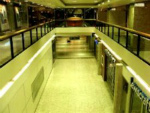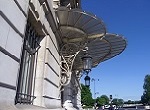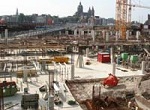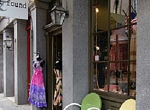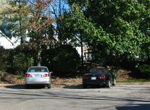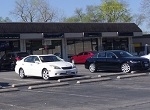Shopping Center Renovation: What To Try
Last Updated: October 24, 2022
Shopping center renovation could be your first thought when you recognize that your local regional mall or strip center is starting to falter. Those are the optimists among you; the pessimists have long since decided that online shopping killed retail stores, and if some were still kicking, the pandemic finished them off. They might be right. But we know many of our readers are optimistic with a bias toward action. So we proceed.
First, we will deal with the regional mall; in the third heading, we will talk about somewhat newer types of shopping centers often anchored by a large discount retailer rather than a department store or two. In the end, the strategies are not all that different.
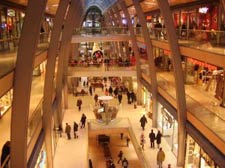
Many of you will ignore our advice to redevelop a conventional regional mall as a mixed-use property so that it is less subject to the boom-or-bust cycle common in retail.
You'll say your municipality relies on sales tax receipts, or that property values will fall if you lose the upscale stores you might now enjoy.
But increasingly, department stores, as well as the older large-format stores such as J.C. Penney, are irrelevant in America. These stores that have anchored regional malls for the last few decades may actually go out of business quite soon. So our best advice would be to take a rational look at whether it is even viable to consider a renovation project for that type of shopping center, or whether you should be exploring new land uses and new sources of municipal revenue.
To be fair, a few of you will be correct in opting for the upgrade and fresh look. You fall into that category if your area genuinely still has a market supportive of the square footage of retail space you have and the caliber of stores that your local population demands.
The first task is to figure out how to approach owners and managers that are not proposing any shopping center renovation plans, even though the retail atmosphere has become a little tacky.
Most shopping malls in the U.S., (as well as a fair number of the larger
strip centers and lifestyle centers we will discuss in the next section) are owned by large out-of-town
corporations. There may be a mall manager, and you can and should sit
down to discuss the community's wish to see a shopping center
renovation.
If you are a concerned citizen, by all means take the mayor with you. Also bring other influential community members who may help you accurately assess the situation.
In most cases you will not be hearing any "straight talk" from the local mall manager. To be fair, they may not know the true intentions of the owner of the center, but even if they do know, they probably will not be allowed to share that information.
Keep calling further and further up the organizational ladder until someone finally refuses to give you any more contact information or starts answering your questions.
Here are the key pieces of information the community would like to know:
- Whether there are any plans to sell the shopping center and/or the underlying piece of real estate.
- Whether there are plans to make physical improvements to the property in an effort to gain new tenants.
- Management's explanation as to why the center is having difficulty.
- Management's experience with and openness to unconventional approaches to generating revenue from dead malls or tired centers that have too many vacancies.
- Ownership's willingness and ability to spend some serious money to make a better impression on potential customers.
- Management's willingness to address safety concerns by physically closing a portion of the mall or center, at least for retail traffic purposes, to concentrate the small amount of traffic into occupied areas.
- Whether the owners would consider redevelopment into land uses that are more needed in the community, in light of the staggering surge in online shopping and superstores for the price-conscious shopper.
Advice to the Community Facing a High-Vacancy Shopping Area
In this section I'm going to talk to "you," but of course I'm talking to you the community, you the elected official, and you the group of concerned citizens.
First of all, I sympathize. I recently lived in an area where a regional mall failed. Within a decade or so, I went from living eight blocks away from a powerhouse center with two major department stores, two large-format stores, numerous franchise shops and a few locally owned ones, a movie theater, restaurants, and a food court, to living eight blocks away from a mostly empty shell in a building showing its age (or more accurately, its poor design choices).
If this is your situation, you can try to appeal to the mall owner's best self by asking for a major reinvestment in a shopping center renovation.
If your state law allows economic development incentives such as tax increment financing, you may have to consider granting some concessions, especially if you're in a competitive situation with other suburbs. But do try not to give away very much.
Since newer seems to sell over older in the mall business, you are going to have to escalate the war and make your mall the new favorite destination for a little while.
Far from an ideal solution, at least it will postpone the service cuts while you pursue another revenue strategy for your municipality, such as regional pooling of sales tax revenues.
But What About Shopping Centers Anchored By Major Discount Retailers?
We promised at the top of the article to talk about those other types of shopping centers, the ones that use Walmart, Costco, or Target as their most important anchor tenant. (If the object of your concern is a strip center, we now have a page devoted specifically to strip mall redevelopment and urge you to check that out, even though you might learn a thing of two on this page as well.)
The centers that are anchored by the discount stores tend to be a bit newer than regional malls, and are more diverse in their physical layout as well. Some resemble two strip malls facing one another, with parking in between. Many feature the anchor discount store on one side of a massive parking lot facing on the street, with a few smaller stores beside the discount store. Others string together several of these larger anchor stores, which in addition to a Target, for example, might also include a Michael's, Kohl's, or other fairly large store. It is also very common that the main configuration of stores be accompanied by some outlots closer to the main thoroughfare, which might be occupied by other stores, buildings hosting a few small shops, or chain restaurants.
When you notice this type of shopping center faltering--and in most cases, you will indeed ultimately have to suffer through that fate--you also need to face squarely how you will either quickly convince and pressure the shopping center owners to renovate, while also hedging your bets at city hall to figure out how you are going to replace the lost revenue if the worst occurs.
We think the renovation issues are similar, whether we are talking about a regional mall or a newer discounter-anchored shopping center. There are two major differences: (a) the regional mall anchored by department stores is definitely on its last legs in most U.S. markets, and (b) the discounter-anchored shopping center might be renovation-worthy if communities, landlords, and the real estate industry react a whole lot quicker than they did when the writing was on the wall for the regional malls.
Below we give you some ideas about shopping center renovation in general.
Giving the Shopping Center a Facelift
If you stick with retail, the shopping center renovation should entail a major cosmetic facelift. Every surface, both on the exterior and interior, should look or be brand-spanking new.
Reconfigure the actual arrangement of stores. Create attractive and
versatile outdoor spaces between clusters of shops, unless you are in
the most severe of climates.
Even then, some outdoor space is popular and necessary today. If you can renovate the parking area and entrances so they look different, do that also. Change the appearance the most you possibly can within a reasonable budget.
You should consider heavy parking lot landscaping, incorporating some green infrastructure to offset the tremendous volume of stormwater runoff that can lead to flash flooding. In practical terms, this means making the landscape islands retain rain or snow melt for a short time; thus they will be lower in elevation than the parking lot surface.
Then impose a community improvement, business improvement, or special business district, or whatever is legal in your state as a means of collecting extra sales tax to help pay for refurbishing. If the city has to give an economic development incentive package, make it the least that will possibly do the job.
Next, change the name. Names evoke a mood, so position your mall or shopping area carefully for its future. Disassociate yourself with the failed center as much as possible.
If security is a problem or a perceived problem, post friendly security guard-hosts everywhere. Give them a unique greeting phrase, coupons to distribute, or an interesting and entertaining persona.
For example, maybe the security folks are clowns or elves or info-babes. If the problem has been extreme, have them offer to escort shoppers to their parking spaces.
More Unusual Ideas for Filling Your Retail Spaces
If you need creative option suggestions, chances are you are ignoring our advice on the shopping center redevelopment page that you should seek mixed-use development instead of placing all of your faith in retail.
However, if impartial market analyses show that the market is still there, but maybe it is marginal or needs a unique spin to differentiate itself from the competition, keep reading and thinking.
Currently there is much interest in "going green," so consider using your outdoor space creatively. If you have wetlands or mountains or forest to show off, do so. Place food and beverages for sale nearby. Food trucks fill the gap when you are not yet ready to attract permanent restaurants or snack sheds.
Perhaps you also can attract a semi-permanent demonstration of the latest wind turbine, solar panels, electric car, drone, and so forth.
Shopping center renovation really could be all about food. If there are local favorites, give them favorable terms that they cannot refuse. Encourage pop-up restaurants and shops until your shopping center can command a multi-year lease.
If you have to pull a few local gourmet cooks out of their kitchens to become entrepreneurs, do it. Of course offer generous entrepreneurship support if you try such a thing. (Incidentally, a common commercial kitchen can work wonders in this situation.)
Woo great operators from the next city and give them prominent locations after the shopping center renovation.
Develop unique shops based on successful local stores found elsewhere in the metropolitan area. Try the "I will if you will" approach to business attraction. Aim for at least 20% of the stores to be leased all at once to local merchants.
Also try selling the world. Instead of the same tired collection of stores that other malls offer, find entrepreneurs who want to establish an Irish, German, or Danish store. These could be kiosks, or you could convert the entire center to a single ethnic group with a large population in the area if you think doing so won't drive away shoppers from other backgrounds.
Maybe you have Afghan or Guatemalan immigrants that can offer something unique. If so, give them space.
You could give artists free studio space in return for opening
their studio during the afternoons. A variation of this was tried
as an interim solution in suburban Crestwood in the St. Louis area, with mixed results. Certainly this strategy was not the permanent solution and only lasted a short time. (In case you are wondering, ultimately the entire shopping center renovation strategy failed, resulting in a messy environmental cleanup operation, a few failed redevelopment agreements, and a current redevelopment featuring an anchor grocery store and suburban-style homes.)
Bring in piano teachers and tutors, so that parents will be captive shoppers. Instead of silly-looking massage chairs, bring in a real masseuse. Just be willing to insist that the owners of your local mall or strip center question the typical shopping center success formula before you invest public dollars or the public trust in a shopping center renovation.
YOU MAY NEED TO READ MORE ABOUT THESE TOPICS:
- Making and Keeping a Good Community >
- Community Challenges, Common Topics & Concepts >
- Economic Development > Shopping Center Renovation
Join GOOD COMMUNITY PLUS, which provides you monthly with short features or tips about timely topics for neighborhoods, towns and cities, community organizations, and rural or small town environments. Unsubscribe any time. Give it a try.
